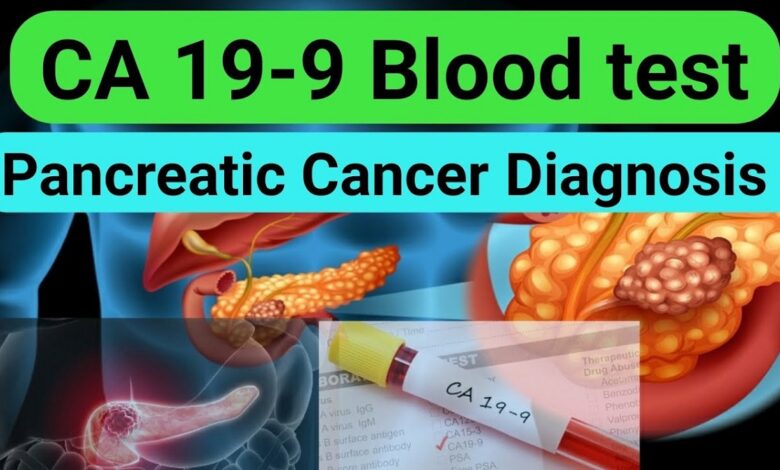Understanding CA 19-9: Its Role and Limitations in Pancreatic Cancer Management

CA 19-9, also known as Carbohydrate Antigen 19-9, is a type of tumour marker primarily used in the medical field to monitor the treatment and progression of pancreatic cancer. This article aims to provide a comprehensive overview of this, including its discovery, function, clinical uses, and limitations.
Discovery and Nature of CA 19-9:
CA 19-9 changed into first recognized within the late 1970s and early Nineteen Eighties through studies on colorectal cancer. It is a kind of glycoprotein, which means it consists of both protein and carbohydrate components. The marker isn’t always precise to cancer cells. It may be positioned inside the tissues of the gastrointestinal tract in wholesome people. However, its degrees have a tendency to upward thrust notably in the presence of positive sorts of cancer, in particular pancreatic cancer.
Function and Significance:
The primary role of CA 19-9 is as a biomarker in oncology. It is not used for cancer screening or diagnosis due to its lack of specificity. Instead, its main function is in monitoring the treatment response and progression of pancreatic cancer.
Clinical Uses:
- Monitoring Treatment Response: CA 19-9 levels are measured before, during, and after treatment to assess the effectiveness of therapies like chemotherapy, radiation, or surgery.
- Detecting Recurrence: After successful treatment, regular monitoring it can help in early detection of cancer recurrence.
- Prognostic Tool: High levels of CA 19-9 at diagnosis can indicate a more aggressive form of cancer and help in prognosis determination.
Limitations and Considerations:
- Not a Screening Tool: Due to its low specificity, This is not suitable for cancer screening. Elevated levels can also be seen in other conditions like cirrhosis, hepatitis, and gallstones.
- False Negatives: Some patients, particularly those lacking the Lewis antigen (about 5-10% of the population), do not produce CA 19-9, even in the presence of cancer.
- False Positives: Elevated it can occur in benign conditions, leading to false positives.
- Individual Variability: Levels can vary widely among individuals and over time, necessitating careful interpretation alongside other clinical findings.
Future Prospects:
Research continues into improving the specificity and sensitivity of CA 19-9 and finding complementary biomarkers that could enhance its clinical utility. The integration of this with advanced imaging techniques and molecular profiling is a promising area of study that could lead to more personalized and effective cancer management strategies.
FAQs:
Q1: What is CA 19-9 and what is its primary use in medicine?
- Carbohydrate Antigen 19-9, is a tumor marker primarily used for tracking the remedy and progression of pancreatic cancer. It is a glycoprotein that could indicate modifications in cancer fame, even though it isn’t always used for screening or preliminary analysis due to its loss of specificity.
Q2: Can CA 19-9 be used for cancer screening?
- No, It is not suitable for cancer screening. Its elevated levels are not specific to cancer and can also be present in various benign conditions such as cirrhosis, hepatitis, and gallstones, making it unreliable for screening purposes.
Q3: Why can’t some people produce CA 19-9, even if they have cancer?
- Approximately 5-10% of the population lacks the Lewis antigen, a necessary component for the production of CA 19-9. As a result, these individuals do not produce, even if they have cancer, leading to false-negative results.
Q4: In what ways is CA 19-9 used in the clinical management of cancer?
- This is used in several ways, including monitoring the effectiveness of treatments like chemotherapy and surgery, detecting cancer recurrence after treatment. And serving as a prognostic tool to assess the aggressiveness of the cancer.
Q5: Are there limitations to using CA 19-9 in cancer management?
- Yes, there are significant limitations. It can give false positives in benign conditions and false negatives in individuals lacking the Lewis antigen. Its levels also vary widely among individuals and over time, requiring careful interpretation alongside other clinical findings.
Conclusion:
CA 19-9 remains an important tool in the management of pancreatic cancer, particularly in monitoring treatment response and progression. However, its use must be contextualized within a broader clinical picture due to its limitations in specificity and sensitivity. Ongoing research and advancements in cancer biomarkers are expected to enhance the role of this in oncology.




